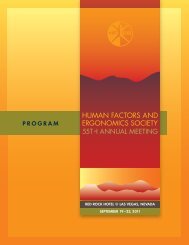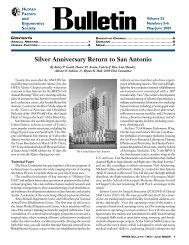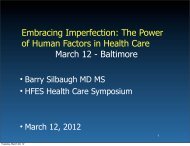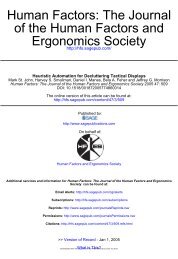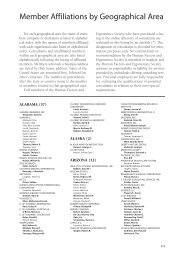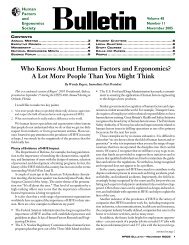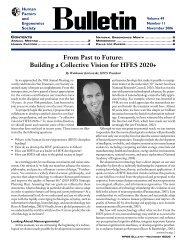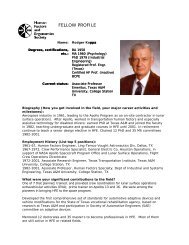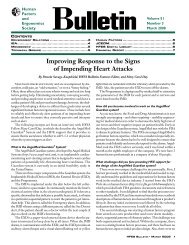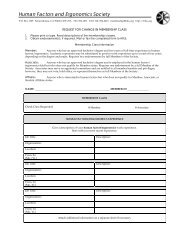MOBILE-READY - Human Factors and Ergonomics Society
MOBILE-READY - Human Factors and Ergonomics Society
MOBILE-READY - Human Factors and Ergonomics Society
Create successful ePaper yourself
Turn your PDF publications into a flip-book with our unique Google optimized e-Paper software.
15. Michael E. Rakauskas, Justin S. Graving, <strong>and</strong>Michael P. Manser, U. of Minnesota; James W.Jenness, Westat, Determining the Accuracy<strong>and</strong> Acceptance of Using Driver InterfaceDisplay Components <strong>and</strong> Fuel EconomyInformation Types16. Mustapha Mouloua, Amber Ahern, <strong>and</strong> EdwardRinalducci, U. of Central Florida; Pascal Alberti,U. de Technologie de Compiègne; J. ChristopherBrill, Old Dominion U.; Adrian Quevedo, NFBResearch Labs, Inc., The Effects of TextMessaging on Driver Distraction: A Bio-Behavioral Analysis17. Justin S. Graving, Michael E. Rakauskas, <strong>and</strong>Michael P. Manser, U. of Minnesota; James W.Jenness, Westat, Inc., A Binary ResponseMethod to Determine the Usability of SevenIn-Vehicle Fuel Economy Displays18. Andre Garcia, Carryl Baldwin, <strong>and</strong> Matt Dworsky,George Mason U., Gender Differences in SimulatorSickness in Fixed- Versus Rotating-Base Driving Simulator<strong>Ergonomics</strong>19. Massimiliano Pau, Federica Corona, BrunoLeban, Elisa Priolo, <strong>and</strong> Marco Pau, U. ofCagliari, Postural Sway <strong>and</strong> Foot-GroundRelationship Are Significantly Modified byBackpack Carriage During Upright Stance:A Study on Primary SchoolchildrenModeling <strong>and</strong> Simulation20. Ming-I Br<strong>and</strong>on Lin, National Cheng Kung U.,Predicting <strong>Human</strong> Pulmonary VentilationUsing Artificial Neural NetworkUniversity Lab PostersCentral Michigan U.Driver Evaluation, Education, <strong>and</strong> ResearchCenterClemson U.<strong>Human</strong> <strong>Factors</strong> in Complex Environments LabGeorgia TechProblem Solving <strong>and</strong> Educational Technology Lab<strong>Human</strong> <strong>Factors</strong> <strong>and</strong> Aging LabNew Mexico State U.Perception, Action, <strong>and</strong> Cognition in Mediated,Artificial, <strong>and</strong> Naturalistic Environments LabPurdue U.Group Performance Environments Research LabTexas Tech U.<strong>Human</strong> <strong>Factors</strong> Psychology Program LabU. of MichiganCenter for <strong>Ergonomics</strong>VE2 – LEARNING IN VIRTUAL ENVIRONMENTSLectureWednesday, September 29, 2010, 10:30 a.m. to12:00 noonGarden A (Atrium Lobby Level)Virtual EnvironmentsChair: Laura Strater, SA Technologies; Cochair:Heather Lum, U. of Central Florida1. Zhiqiang Luo, Nanyang Technological U.;Christopher D. Wickens, Alion Science <strong>and</strong>Technology; Henry Been-Lirn Duh, National U.of Singapore; I-Ming Chen, Nanyang TechnologicalU., Integrating Route <strong>and</strong> Survey Learningin Complex Virtual Environments: Using a3-D Map2. Davin Pavlas, Kyle Heyne, Wendy Bedwell,Elizabeth Lazzara, <strong>and</strong> Eduardo Salas, U. ofCentral Florida, Game-Based Learning: TheImpact of Flow State <strong>and</strong> Videogame Self-Efficacy3. Michael J. Singer, <strong>and</strong> John Barnett, U.S. ArmyResearch Inst.; Grant Taylor, ConsortiumResearch Fellow, Military Training in VirtualEnvironments: User Interface Evaluations4. S<strong>and</strong>ro Scielzo, Fleet Davis, Jennifer M. Riley, <strong>and</strong>John Hyatt, SA Technologies; Donald Lampton,U.S. Army Research Inst.; James Merlo, U.S.Military Academy, Leveraging Serious Games<strong>and</strong> Advanced Training Technologies forEnhanced Cognitive Skill Development5. Alex<strong>and</strong>ra Proaps <strong>and</strong> James Bliss, Old DominionU., Team Performance as a Function of TaskDifficulty in a Computer GameWednesday, September 2912:00 noon to 1:30 p.m.Technical Group Networking/Business MeetingsAgingMarina Room (Bay Level)12:00 noon to 1:30 p.m. (lunch)Perception <strong>and</strong> PerformancePacific Concourse L (Pacific Concourse Level)12:00 noon to 1:30 p.m. (lunch)Wednesday, September 291:30 to 3:00 p.m.AS5 – AIR TRAFFIC CONTROL AND FLIGHTDECK STRATEGIESLectureWednesday, September 29, 2010, 1:30 p.m. to 3:00 p.m.Seacliff A (Bay Level)Aerospace SystemsChair: Lori McDonnell, NASA Ames Research Ctr.;Cochair: Veronika Prinzo, Federal Aviation Admin.1. Deepti Surabattula, Michael Kaplan, <strong>and</strong> StevenJ. L<strong>and</strong>ry, Purdue U., Controller Interventionsto Mitigate Potential Air Traffic Conflicts2. Esa M. Rantanen, Rochester Inst. of Technology;Christopher D. Wickens, Alion Science <strong>and</strong>Technology, Are There St<strong>and</strong>ard ConflictResolution Maneuvers in Air Traffic Control?3. Julian Sanchez <strong>and</strong> Elly C. Smith, MITRE Corp.,Tower Controllers’ Response Behavior toRunway Safety Alerts4. Sarah V. Ligda <strong>and</strong> Arik-Quang V. Dao, NASAAmes/San Jose State U. Research Foundation;Kim-Phuong Vu <strong>and</strong> Thomas Z. Strybel,California State U., Long Beach; Vernol Battiste,NASA Ames/San Jose State U. Research Foundation;Walter Johnson, NASA Ames Research Ctr.,Impact of Conflict Avoidance ResponsibilityAllocation on Pilot Workload in a DistributedAir Traffic Management System5. Yaniv Minkov, Yuval Lerner, Ronny Ophir, <strong>and</strong>Tal Oron-Gilad, Ben-Gurion U. of the Negev,Display Type Effects in Military OperationalTasks Using UAV Video Images: ComparisonBetween Two Types of UAV Feeds—Mini <strong>and</strong>MALE (Medium Altitude Long Endurance)UAVsC1 – FROM VOCAL CORDS TO <strong>MOBILE</strong>COMPUTING: UNDERSTANDING HOW WECOMMUNICATELectureWednesday, September 29, 2010, 1:30 p.m. to 3:00 p.m.Seacliff B (Bay Level)CommunicationChair: Sehchang Hah, Federal Aviation Admin.;Cochair: Kristi Schmidt Bauerly, Apple1. Christopher K. McClernon, Mathew A.Middendorf, Gregory J. Funke, Michael J. Harter,<strong>and</strong> Benjamin A. Knott, U.S. Air Force ResearchLab, Infrasonic Measures as an Index ofWorkload2. Bonny Parke <strong>and</strong> Alan Hobbs, NASA Ames/SanJose State U. Research Foundation; BarbaraKanki, NASA Ames Research Ctr., Passing theBaton: An Experimental Study of ShiftH<strong>and</strong>over3. Joshua B. Hurwitz, David J. Wheatley, KeshuZhang, <strong>and</strong> Young Seok Lee, Motorola, Inc.,Using Location History to Identify Patternsin Mobile Users’ Visits to Establishments4. Alan B. Poole, Georgia Tech; Kelly E. Caine,Indiana U.; Arthur D. Fisk <strong>and</strong> Wendy A. Rogers,Georgia Tech, Errors of Disclosure inComputer-Mediated Systems5. Jennifer Cloud-Buckner, Jennie J. Gallimore, <strong>and</strong>Rosalyn Scott, Wright State U., TheoreticalDiscussion of CAMOCS <strong>and</strong> RIAS CommunicationModels to Support Health CareInformation Technology DevelopmentGS5 – ARNOLD M. SMALL LECTURE IN SAFETYInvited AddressWednesday, September 29, 2010, 1:30 p.m. to 3:00 p.m.Gr<strong>and</strong> Ballroom A (Street Level)General Sessions; cosponsored by SafetyChair: Michael J. Kalsher, Rensselaer Polytechnic Inst.Invited Speaker: Matthew B. Weinger, Director, Ctr. forPerioperative Research in Quality <strong>and</strong> Norman TySmith Chair in Patient Safety <strong>and</strong> Medical Simulation,V<strong>and</strong>erbilt U. Medical Ctr., If Not By You, ThenWhom? <strong>Human</strong> <strong>Factors</strong> Contributions to PerioperativePatient SafetyGS6 – BLASPHEMY OR PRAGMATICS? WHENNOT TO FOLLOW USER-CENTERED DESIGNTECHNIQUESDiscussion PanelWednesday, September 29, 2010, 1:30 p.m. to 3:00 p.m.Bayview B (Bay Level)General SessionsChair: Anthony D. Andre, Interface Analysis Assoc.Panelists: Jay Elkerton, Emerson ProcessManagement; Steve Portigal, Portigal Consulting;Cordell Ratzlaff, Cisco; Dan Saffer, Kicker Studio;Dan Rosenberg, SAPHC5 – HEALTH CARE WORKFLOW, RESEARCHIMPLICATIONSLectureWednesday, September 29, 2010, 1:30 p.m. to 3:00 p.m.Garden Room B (Atrium Lobby Level)Health CareChair: Adam Pickens, TAMHSC-School of Rural PublicHealth; Cochair: Christopher Lee, U. of Central Florida1. Rupa Sheth Valdez, Edmond Ramly, <strong>and</strong> PatriciaFlatley Brennan, U. of Wisconsin-Madison,Development of a Research Agenda at theIntersection of Industrial <strong>and</strong> SystemsEngineering <strong>and</strong> Health Care: Implicationsfor <strong>Human</strong> <strong>Factors</strong> <strong>and</strong> <strong>Ergonomics</strong>2. Tobias Grundgeiger <strong>and</strong> Penelope M. S<strong>and</strong>erson,U. of Queensl<strong>and</strong>; Cristina Beltran Orihuela <strong>and</strong>Andera Thompson, Princess Alex<strong>and</strong>ra Hospital;Hamish G. MacDougall, U. of Sydney; LeoNunnink, Princess Alex<strong>and</strong>ra Hospital;Balasubramanian Venkatesh, U. of Queensl<strong>and</strong>,Distractions <strong>and</strong> Interruptions in theIntensive Care Unit: A Field Observation<strong>and</strong> a Simulator Experiment3. Alissa L. Russ, Jason J. Saleem, M. Sue McManus,Richard M. Frankel, <strong>and</strong> Alan J. Zillich, RoudebushVA Medical Ctr., The Workflow of ComputerizedMedication Ordering in PrimaryCare Is Not Prescriptive4. Leigh A. Baumgart, Ellen J. Bass, <strong>and</strong> Jason A.Lyman, U. of Virginia; Sherry Springs, NorthCarolina A&T State U.; John Voss, Gregory F.Hayden, Martha A. Hellems, Tracey R. Hoke,Katharine Schlag, <strong>and</strong> John Schorling, U. ofVirginia, Supporting Physicians’ Practice-Based Learning <strong>and</strong> Improvement (PBLI)<strong>and</strong> Quality Improvement Through Explorationof Population-Based Medical Data5. Cakil Sarac, Rhona Flin, Kathryn Mearns, <strong>and</strong>Jeanette Jackson, U. of Aberdeen, MeasuringHospital Safety Culture: Testing the HSOP-SC Scale



